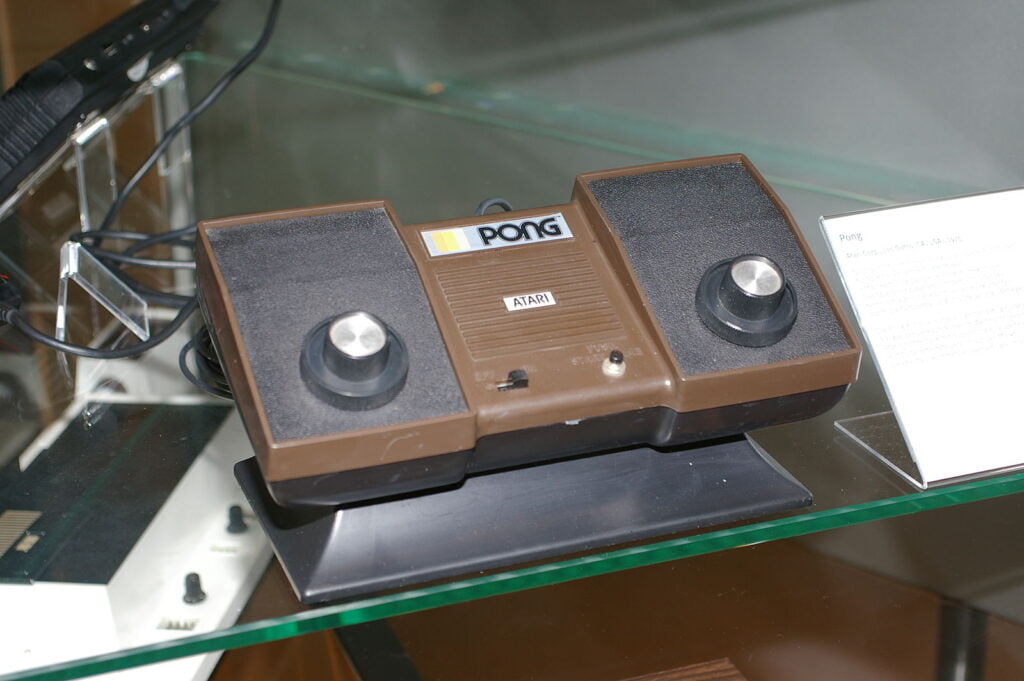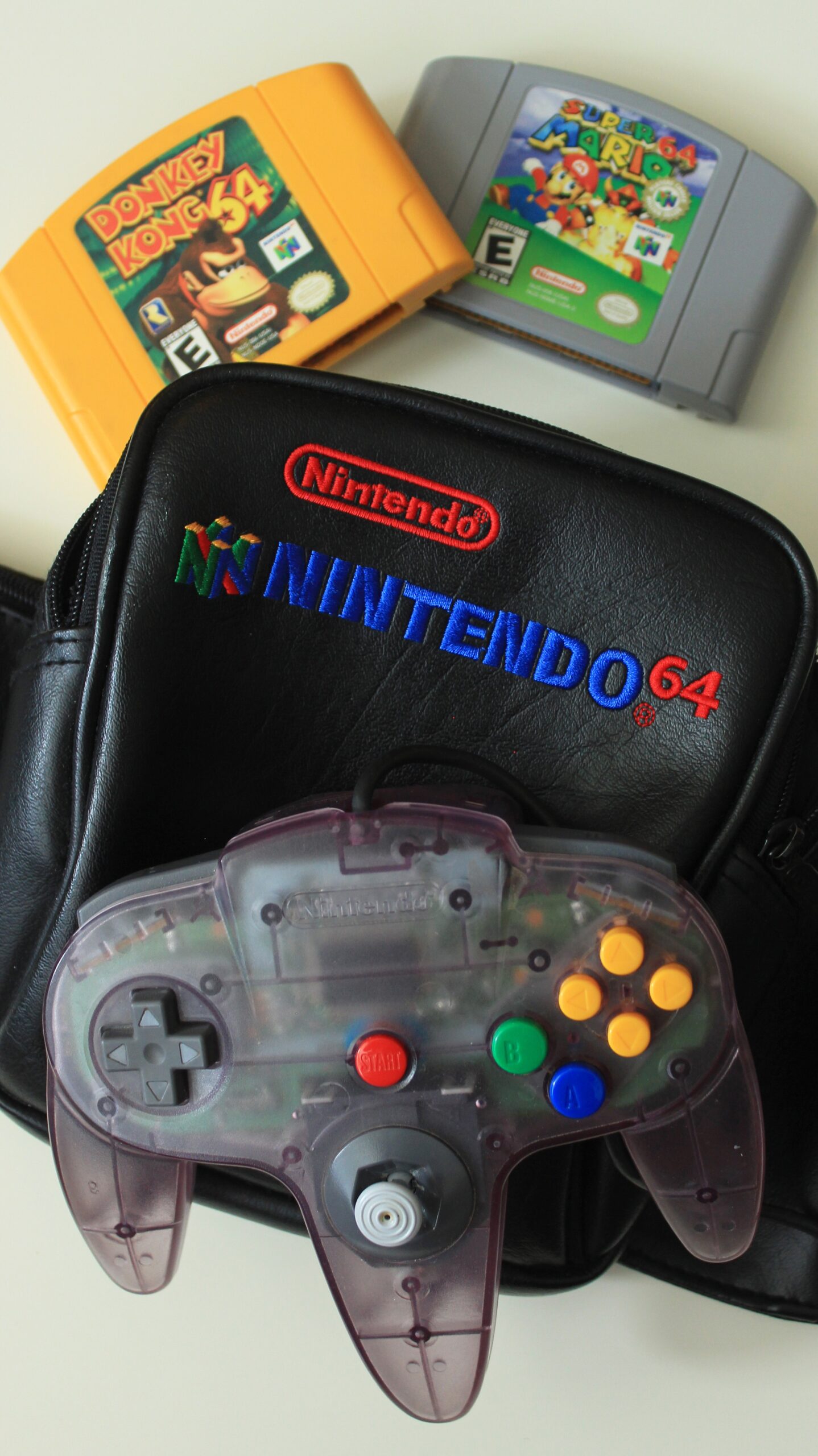When we think of retro gaming, we’re often filled with nostalgia for the pixelated worlds, iconic characters, and unforgettable soundtracks of our childhoods. But what exactly constitutes retro gaming? That depends on who you ask, how old they are, when they started gaming, and a whole host of other factors.
This post represents what I consider retro gaming (I, being a middle aged male, too young to have owned an Atari 2600, but definitely old enough to have seen them in the bedrooms of friends older siblings, alongside Commodore 64s and old clunky CRT TVs) where I’ll be identifying key periods and elements that define what I consider retro gaming – basically Pong through to the Nintendo 64. We’ll also explore the significance of retro gaming in popular culture, its impact on modern gaming, and the enduring appeal of these classic games.
| Console Name | Manufacturer | Year of Release | Estimated End of Mainstream Use |
|---|---|---|---|
| Magnavox Odyssey | Magnavox | 1972 | 1975 |
| Pong (Home Version) | Atari | 1975 | Late 1970s |
| Atari 2600 | Atari | 1977 | Late 1980s |
| Intellivision | Mattel Electronics | 1979 | 1984 |
| ColecoVision | Coleco | 1982 | 1985 |
| NES (Famicom) | Nintendo | 1983 | Early 1990s |
| Sega Master System | Sega | 1985 | 1992 |
| Atari 7800 | Atari | 1986 | Late 1980s |
| Game Boy | Nintendo | 1989 | Mid 1990s |
| Sega Genesis (Mega Drive) | Sega | 1988 | Mid 1990s |
| Super Nintendo Entertainment System (SNES) | Nintendo | 1990 | Late 1990s |
| PlayStation | Sony | 1994 | Early 2000s |
| Sega Saturn | Sega | 1994 | Late 1990s |
| Nintendo 64 | Nintendo | 1996 | Early 2000s |
The First Wave of Video Games (1970s)
The 1970s marked the beginning of the video game industry, with the release of the first commercial arcade game and home console. This decade was characterised by simple, yet addictive gameplay mechanics and a growing fascination with interactive entertainment.
Magnavox Odyssey (1972) – first home video game console

Launched in 1972, the Magnavox Odyssey holds the distinction of being the world’s first home video game console. Developed by Ralph H. Baer and his team, the Odyssey pioneered a whole new realm of entertainment, catapulting video gaming from the confines of laboratories into living rooms.
Although simplistic by today’s standards, the Magnavox Odyssey was groundbreaking at the time. It offered a collection of different games, a novel concept for an era when most video games were standalone arcade machines. Each game, from table tennis to hockey, was facilitated through removable circuit cards inserted into the console and an overlay applied on the television screen to provide game-specific visuals.
The console wasn’t just a technological breakthrough; it was a social catalyst, introducing a new mode of interaction. For the first time, families and friends could gather around a TV not just to watch a program, but to engage in a shared game-playing experience. The console successfully merged technology and entertainment, defining a new path for home recreation.
While Odyssey’s sales were modest compared to the subsequent successes of consoles like Atari’s Pong or the Nintendo Entertainment System, its influence is undeniable. As the world’s first home console, it set the stage for the video gaming industry’s explosive growth and marked the beginning of a new era in home entertainment. Today, the Magnavox Odyssey is remembered as a pioneering relic that sparked the home video game revolution, paving the way for a booming industry that continues to evolve and captivate.
Pong (1975) – Atari

In 1975, Pong, the popular arcade sensation, leaped from the arcade realm into the homes of millions, catalyzing the rise of the video game industry. Originally an arcade phenomenon since its 1972 release, Pong’s move to the living room, through a partnership between Atari and Sears, marked a revolution in home entertainment. The console was simplistic, offering just the single game – Pong, but its impact was far-reaching.
Under the Sears’ “Tele-Games” brand, the home version of Pong became an instant success, selling over 150,000 units during its first holiday season. With simple setup, easy-to-use controls, and a compelling table tennis simulation, it introduced video gaming to countless households, transcending age and skill barriers.
Pong’s home version represented more than just a gaming milestone. It was a social phenomenon that offered a new dimension of interaction, intertwining technology with entertainment. The excitement of gameplay fostered bonding experiences among family and friends, establishing video games as a popular form of home entertainment.
Though technologically primitive by modern standards, the home version of Pong holds an indelible place in video game history. Its success laid the groundwork for the industry’s future, leading to the rise of gaming giants like Nintendo, PlayStation, and Xbox. Despite being eclipsed by more advanced games, Pong’s legacy as the forerunner of home gaming persists, a testament to the enduring appeal of simple, engaging gameplay.
Atari 2600 (1977) – the console that popularised home gaming
The Atari 2600, released in 1977, revolutionised home gaming with its interchangeable game cartridges and a diverse library of titles. Games like Space Invaders and Pac-Man became household names, and the Atari 2600’s success cemented the company’s position as a leader in the video game industry.
The Golden Age of Arcade Games (1980s)
The 1980s saw the rise of the arcade culture, with teenagers flocking to local arcades to compete for high scores and socialize with friends. This period is often referred to as the golden age of arcade games, featuring innovative gameplay, vibrant graphics, and catchy soundtracks.
Pac-Man (1980) – Namco
Arguably the most iconic arcade game of all time, Pac-Man was developed by Namco and created by Toru Iwatani. With its simple yet addictive gameplay, colorful graphics, and unforgettable music, Pac-Man quickly became a cultural phenomenon. The game’s success not only solidified its place in the history of video games but also set the stage for future maze-based and character-driven games.
Donkey Kong (1981) – Nintendo
Donkey Kong, developed by Nintendo and designed by Shigeru Miyamoto, introduced the world to a plucky Italian plumber named Mario. The game’s innovative platforming mechanics and memorable characters laid the foundation for countless future franchises, including the Super Mario series.
The video game crash of 1983
The video game crash of 1983 was a dark period in the history of the industry, caused by an oversaturated market, low-quality games, and increased competition from home computers. The crash led to a significant decline in console sales and the collapse of several prominent game developers. However, it also paved the way for the rise of Japanese video game consoles, which would dominate the market in the years to come.
The Rise of Japanese Video Game Consoles (1983-1990)
In the wake of the video game crash, Japanese companies like Nintendo and Sega emerged as major players in the video game industry. They introduced new consoles that focused on quality, innovation, and engaging gameplay, quickly winning the hearts of gamers worldwide.
Nintendo Entertainment System (NES) (1983)
The NES, released in 1983, marked Nintendo’s entry into the home console market. With its iconic controller and a library of memorable games, the NES helped revitalize the video game industry. Titles such as Super Mario Bros., The Legend of Zelda, and Metroid not only showcased the capabilities of the console but also became cornerstones of gaming history.
Sega Master System (1985)
As a response to the NES, Sega introduced the Master System in 1985. Although it didn’t achieve the same level of success as the NES, the console featured some notable games like Alex Kidd in Miracle World and Phantasy Star. Sega’s Master System laid the groundwork for the company’s future consoles and its rivalry with Nintendo.
Game Boy (1989)
Nintendo continued to innovate with the release of the Game Boy in 1989, a handheld console that brought gaming on the go. With its monochromatic display and long battery life, the Game Boy captured the imagination of gamers everywhere. Notable games like Tetris and Pokémon Red and Blue became instant classics, further solidifying Nintendo’s dominance in the market.
The console wars between Nintendo and Sega
The rivalry between Nintendo and Sega, known as the console wars, was a defining aspect of the late 1980s and early 1990s. Both companies sought to outdo each other in terms of hardware, game libraries, and marketing tactics, resulting in a fierce competition that pushed the boundaries of gaming technology and creativity.
The Transition to 3D Gaming (1990s)
The 1990s ushered in a new era of gaming, marked by the transition from 2D to 3D graphics, the rise of CD-based games, and increased emphasis on storytelling and immersion. This decade saw the release of several iconic consoles and games that still resonate with gamers today.
Super Nintendo Entertainment System (SNES) (1990)
The SNES, released in 1990, built upon the success of the NES, offering improved graphics, sound, and gameplay. Classic titles such as The Legend of Zelda: A Link to the Past and Super Metroid demonstrated the capabilities of the console, while also providing unforgettable gaming experiences that remain influential to this day.
Sega Genesis (1988)
Sega’s answer to the SNES was the Sega Genesis, released in 1988. The console boasted a powerful 16-bit processor and a library of engaging games like Sonic the Hedgehog and Streets of Rage. The Sega Genesis continued the rivalry between Sega and Nintendo, pushing both companies to innovate and deliver memorable gaming experiences.
PlayStation (1994) – Sony’s entry into the console market
Sony entered the console market in 1994 with the PlayStation, a CD-based system that offered 3D graphics, high-quality sound, and a vast library of games. Titles such as Final Fantasy VII and Metal Gear Solid showcased the storytelling and visual capabilities of the console, attracting a new generation of gamers and setting the stage for Sony’s future success in the gaming industry.
Nintendo 64 (1996)
The Nintendo 64, released in 1996, brought 3D gaming to the forefront with titles like Super Mario 64 and The Legend of Zelda: Ocarina of Time. The console’s innovative controller and emphasis on four-player multiplayer gaming further distinguished it from its competitors, solidifying its place in the annals of gaming history.
The Future of Retro Gaming
The enduring appeal of retro gaming ensures that its influence on the gaming industry will continue to grow and evolve, presenting exciting opportunities for innovation and creativity.
Games like Shovel Knight, Axiom Verge, and Hyper Light Drifter demonstrate the potential for blending retro and modern gaming elements, offering unique experiences that appeal to both nostalgic gamers and newcomers alike.
As virtual reality (VR) and augmented reality (AR) technologies advance, there are opportunities to reimagine classic games in immersive and interactive environments. This fusion of retro gaming with cutting-edge technology could offer fresh experiences for gamers, while also presenting new challenges and opportunities for developers.
The continued growth of the retro gaming community
Streaming platforms, content creators, and gaming conventions play a crucial role in the continued growth of the retro gaming community. As more people discover and embrace the world of retro gaming, these platforms and events will foster connections, inspire creativity, and help ensure the longevity of the classic games and consoles we know and love.
Retro gaming’s timeless allure captivates gamers of all ages, as the iconic characters, immersive worlds, and unforgettable gameplay experiences continue to resonate with audiences. The history of video games and consoles is a testament to the power of creativity, innovation, and passion, with retro gaming serving as a reminder of the industry’s humble beginnings and its potential for continued growth.
As the retro gaming community thrives, the influence of classic games and consoles on the gaming industry remains strong, inspiring new generations of developers, artists, and gamers to explore the rich history of the medium and create their own unique experiences. With the continued blending of retro and modern gaming elements, advancements in technology, and the ongoing growth of the gaming community, the future of retro gaming looks bright, promising exciting new adventures for gamers of all ages.
